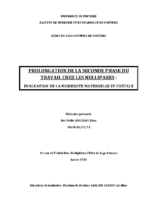Mémoire
Vincelot Elise
Prolongation de la seconde phase du travail chez les nullipares : évaluation de la morbidité maternelle et foetale
FrançaisConsulter le texte intégral (format PDF)

Résumé
Français
Prolongation de la seconde phase du travail chez les nullipares : évaluation de la morbidité maternelle et foetale
OBJECTIFS
Etudier la morbidité maternelle et néonatale à court terme chez des primipares en fonction du temps passé à dilatation complète et mettre en lumière les facteurs influençant la durée de la seconde phase du travail.
MATERIELS ET METHODES
Etude cas témoins rétrospective réalisée dans le Centre Hospitalier Universitaire de Poitiers sur la période du 1er janvier 2010 au 1er juillet 2014. 387 patientes à bas risque obstétrical ont constitué notre population d'étude. Les patientes ayant une seconde phase du travail supérieur ou égale à 180 minutes ont constitué notre population de cas (198) et les patientes restantes ont constitué nos témoins (189).
RESULTATS
On observe une augmentation de la morbidité maternelle chez les femmes ayant une prolongation de la seconde phase du travail. En effet, on observe une augmentation significative du nombre de déchirures périnéales sévères (OR 0,25 ; IC 95% [0,05-0,84]) et d’hémorragie de la délivrance (OR 0,48 ; IC 95 % [0,24-0,94]) comparativement aux femmes ayant une durée de la seconde phase inférieure à 180 minutes. Parallèlement, on assiste à une augmentation du recours aux extractions instrumentales (OR 0,13 ; IC 95% [0,07-0,22]).
L’étude n’a pas montré d’association entre la morbidité néonatale et le temps passé à dilatation complète.
Les facteurs de risques d’une seconde phase du travail prolongé sont les variétés de présentations dystociques (OR 0,39 ; IC 95% [0,23-0,64]) et les nouveau-nés de poids supérieur à 4000 grammes (OR 0,29 ; IC 95% [0,10-0,72]).
CONCLUSION
La prolongation de la seconde phase du travail permet une meilleure orientation du pôle céphalique au moment de l’accouchement et donc diminue les complications liées aux accouchements en variétés postérieures. Cependant, on observe une augmentation significative de la morbidité maternelle mais pas de la morbidité foetale.
Mots-clés libres : prolongation de la seconde phase du travail, nullipares, morbidité maternelle, morbidité néonatale.
- Accouchement
- Naissance
- Femmes nullipares
English
OBJECTIVES
To study short term maternal and neonatal morbidity in nulliparous patients according to the time spent fully dilated and to highlight parameters influencing the duration of this second stage.
PATIENTS AND METHODS
A retrospective cohort case-control study was carried out at Poitiers University Hospital between 1st January 2010 and 1st July 2014. 387 patients with a low obstetrical risk were included in this study. Patients who experienced a second stage of labour superior or equal to 180 minutes made up the case study group (n=198) and the other patients (n=189) the control group.
RESULTS
An increase in global maternal morbidity for women with a prolongation of the second stage was observed. Indeed, there was a significant increase in level three or four perineal lacerations (OR 0.25; IC 95% [0.05-0.84]) and postpartum haemorrhage (OR 0.48; IC 95% [0.24–0.94]) in comparison with the control group. Moreover, there was an increment of operative vaginal delivery (OR 0.13 ; IC 95% [0.07-0.22]).
Conversely, any significant association between neonatal morbidity and the length of the second stage of labour was not demonstrated in this study.
Risk factors of a prolonged second stage of labour were dystocic presentations (OR 0.39; IC 95% [0.23-0.64]) and a foetal birth weight superior to 4000 grams (OR 0.29; IC 95% [0.10-0.72]).
CONCLUSION
Prolongation of the second stage of labour allows for a better orientation of the foetal head during delivery and, consequently, reduces complications linked to occipito-posterior presentations. Nevertheless, there is an increase of global maternal morbidity but no influence on neonatal morbidity.
Keywords : prolongation second stage of labour, nulliparous, maternal morbidity, neonatal morbidity.
Notice
- Diplôme :
- Diplôme état sage femme 5ème année
- Établissement de soutenance :
- Université de Poitiers
- UFR, institut ou école :
- UFR Médecine et Pharmacie
- Domaine de recherche :
- Maïeutique
- Directeur(s) du travail :
- Caroline Carlier-Guérin
- Date de soutenance :
- 02 juillet 2015
Menu :
-
-
à propos d'UPétille
-
Voir aussi
Annexe :

-
Une question ?
Avec le service Ubib.fr, posez votre question par chat à un bibliothécaire dans la fenêtre ci-dessous ou par messagerie électronique 7j/7 - 24h/24h, une réponse vous sera adressée sous 48h.
Accédez au formulaire...
Université de Poitiers - 15, rue de l'Hôtel Dieu - 86034 POITIERS Cedex - France - Tél : (33) (0)5 49 45 30 00 - Fax : (33) (0)5 49 45 30 50
petille@support.univ-poitiers.fr -
Crédits et mentions légales
